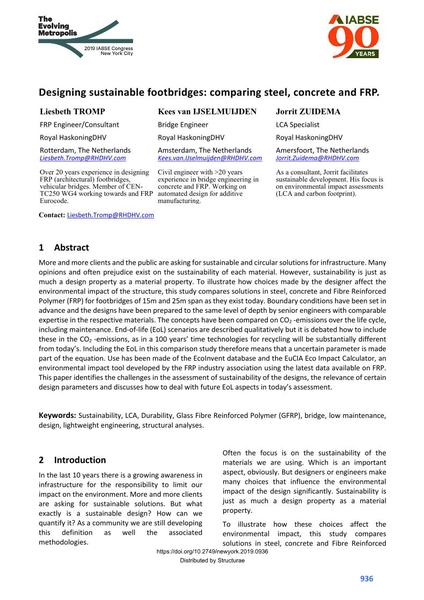Designing sustainable footbridges: comparing steel, concrete and FRP.

|
|
|||||||||||
Bibliographic Details
| Author(s): |
Liesbeth Tromp
(Royal HaskoningDHV)
Kees Van Ijselmuijden (Royal HaskoningDHV) Jorrit Zuidema (Royal HaskoningDHV) |
||||
|---|---|---|---|---|---|
| Medium: | conference paper | ||||
| Language(s): | English | ||||
| Conference: | IABSE Congress: The Evolving Metropolis, New York, NY, USA, 4-6 September 2019 | ||||
| Published in: | The Evolving Metropolis | ||||
|
|||||
| Page(s): | 936-942 | ||||
| Total no. of pages: | 7 | ||||
| DOI: | 10.2749/newyork.2019.0936 | ||||
| Abstract: |
More and more clients and the public are asking for sustainable and circular solutions for infrastructure. Many opinions and often prejudice exist on the sustainability of each material. However, sustainability is just as much a design property as a material property. To illustrate how choices made by the designer affect the environmental impact of the structure, this study compares solutions in steel, concrete and Fibre Reinforced Polymer (FRP) for footbridges of 15m and 25m span as they exist today. Boundary conditions have been set in advance and the designs have been prepared to the same level of depth by senior engineers with comparable expertise in the respective materials. The concepts have been compared on CO₂-emissions over the life cycle, including maintenance. End-of-life (EoL) scenarios are described qualitatively but it is debated how to include these in the CO₂-emissions, as in a 100 years’ time technologies for recycling will be substantially different from today’s. Including the EoL in this comparison study therefore means that a uncertain parameter is made part of the equation. Use has been made of the EcoInvent database and the EuCIA Eco Impact Calculator, an environmental impact tool developed by the FRP industry association using the latest data available on FRP. This paper identifies the challenges in the assessment of sustainability of the designs, the relevance of certain design parameters and discusses how to deal with future EoL aspects in today’s assessment. |
||||
| Keywords: |
design bridge sustainability LCA life-cycle analysis durability low maintenance Glass Fibre Reinforced Polymer (GFRP) lightweight engineering structural analyses
|
||||

